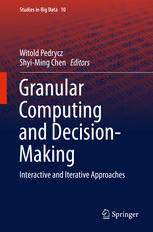
Granular Computing and Decision-Making: Interactive and Iterative Approaches PDF
Preview Granular Computing and Decision-Making: Interactive and Iterative Approaches
Studies in Big Data 10 Witold Pedrycz Shyi-Ming Chen Editors Granular Computing and Decision- Making Interactive and Iterative Approaches Studies in Big Data Volume 10 Serieseditor JanuszKacprzyk,PolishAcademyofSciences,Warsaw,Poland e-mail:[email protected] AboutthisSeries Theseries“StudiesinBigData”(SBD)publishesnewdevelopmentsandadvances in the variousareas of Big Data- quickly and with a high quality. The intent is to coverthetheory,research,development,andapplicationsofBigData,asembedded inthefieldsofengineering,computerscience,physics,economicsandlifesciences. The booksof the seriesrefer to the analysisand understandingof large,complex, and/ordistributeddatasetsgeneratedfromrecentdigitalsourcescomingfromsen- sors or other physical instruments as well as simulations, crowd sourcing, social networksor other internet transactions, such as emails or video click streams and other.Theseriescontainsmonographs,lecturenotesandeditedvolumesinBigData spanningtheareasofcomputationalintelligenceincl.neuralnetworks,evolutionary computation,softcomputing,fuzzysystems, as wellas artificialintelligence,data mining, modern statistics and Operationsresearch, as well as self-organizingsys- tems. Of particular value to both the contributorsand the readership are the short publicationtimeframeandtheworld-widedistribution,whichenablebothwideand rapiddisseminationofresearchoutput. Moreinformationaboutthisseriesathttp://www.springer.com/series/11970 · Witold Pedrycz Shyi-Ming Chen Editors Granular Computing and Decision-Making Interactive and Iterative Approaches ABC Editors WitoldPedrycz Shyi-MingChen DepartmentofElectricalandComputer DepartmentofComputerScienceand Engineering InformationEngineering UniversityofAlberta NationalTaiwanUniversityof Edmonton,Alberta ScienceandTechnology Canada Taipei Taiwan ISSN2197-6503 ISSN2197-6511 (electronic) StudiesinBigData ISBN978-3-319-16828-9 ISBN978-3-319-16829-6 (eBook) DOI10.1007/978-3-319-16829-6 LibraryofCongressControlNumber:2015937370 SpringerChamHeidelbergNewYorkDordrechtLondon (cid:2)c SpringerInternationalPublishingSwitzerland2015 Thisworkissubjecttocopyright.AllrightsarereservedbythePublisher,whetherthewholeorpartof thematerialisconcerned,specificallytherightsoftranslation,reprinting,reuseofillustrations,recitation, broadcasting,reproductiononmicrofilmsorinanyotherphysicalway,andtransmissionorinformation storageandretrieval,electronicadaptation,computersoftware,orbysimilarordissimilarmethodology nowknownorhereafterdeveloped. Theuseofgeneraldescriptivenames,registerednames,trademarks,servicemarks,etc.inthispublication doesnotimply,evenintheabsenceofaspecificstatement,thatsuchnamesareexemptfromtherelevant protectivelawsandregulationsandthereforefreeforgeneraluse. Thepublisher,theauthorsandtheeditorsaresafetoassumethattheadviceandinformationinthisbook arebelievedtobetrueandaccurateatthedateofpublication.Neitherthepublishernortheauthorsor theeditorsgiveawarranty,expressorimplied,withrespecttothematerialcontainedhereinorforany errorsoromissionsthatmayhavebeenmade. Printedonacid-freepaper SpringerInternationalPublishingAGSwitzerlandispartofSpringerScience+BusinessMedia (www.springer.com) Preface Fuzzy decision-making - including its underlying methodology, plethora of algorithmicdevelopmentsandarichanddiversifiedslewofapplicationstudiesform acornerstoneoffuzzysets.Inspiteoftheongoingresearchandalonglistofaccom- plishments, there are still a numberof open and intriguingissues worth pursuing. Inparticular,thereisagenuineneedtocometogripastothedominantaspectsof themethodologyandresultingtechnologyalongwiththeirsystematicandcoherent usage. Theoverarchingthemeofthiseditedvolumedwellsuponthetwokeyfeaturesof decisionmakingprocessesthatbecomequitecommonlypresentthroughoutnumer- ousstudiesandapplications,anddealwithinteractiveanditerativenatureofthese processes.Decision-makingisinherentlyinteractive.Fuzzysetshelprealizehuman- machinecommunicationinanefficientwaybyfacilitatingatwo-wayinteractionin afriendlyandtransparentmanner.Thisinteractioniscarriedoutatasuitablelevel ofinformationgranularitynotconfiningtheusertotheuseofprecisenumericdata. Subsequently any decision support system releases non-numeric findings, which becomehelpfultocomprehendtheresultsandassesspotentialimpactofdecisions beingmade.Human-centricinteractionisofparamountrelevanceasaleadingguid- ing design principle of decision support systems. The facet of interaction comes handin handwithiterativeprocessesofdecision-making.Resultingrecommenda- tionsissued bythe system can beassessed andmay triggeran iterativescheme of gatheringadditionalevidence,refininggoalsandconstraints,assessingthefindings and,ifnecessary,proceedingwiththenextiterativeloop.Forinstance,aniterative natureofdecision-makingbecomesapparentinconsensusbuildingwherea series ofiterations(sessions)amongtheparticipantsiscommonlyobserved. The facets of interactivityand the iterativeway in which decisionsare formed, giverisetothetitleofthisvolume-I2FuzzyDecisionMaking,forbrief.Weareof opinionthateventhoughtheseaspectsofthedecisionprocessesarequitecommon and vividly present in numerous studies, they have not been fully and systemati- callyexploitedandsupportedbythetechnologyoffuzzysets.Theobjectiveofthis volumeistorevisittheunderlyingparadigmandpracticeoffuzzydecision-making emphasizingpivotalfacetsoftheirrealizationinaninteractivityanditerativeway. VI Preface The ultimate objectives of the proposed edited volume is to provide the reader with an updated, in-depth material on the conceptually appealing and practically soundmethodologyandpracticeofI2FuzzyDecisionMaking. The book engagesa wealth of methods of fuzzy sets, bringsnew concepts, ar- chitecturesand practiceof fuzzydecision making.The chapterscovera wealth of ideas,algorithms,andapplications.Thegrowingroleofinformationgranules,Gran- ularComputingandComputingwithWords(CWW)aswellastype-2fuzzysetsis fullyreflectedinthebookwhereanumberofcontributionsaredirectlydevotedto thissubjecteitherbyofferingsomemethodologicalinsightsorpresentinginterest- ingapplications.Thereisagroupofchaptersdealingsequentialdecision-making, consensusbuildingandgroupofdecisionmaking.Representativeapplicationstud- iesincludingairquality,economics,librarymanagement,andimageprocessingare a testimony of the leading role of the technology of fuzzy sets and information granules. Given the leading theme of this undertaking, the book is aimed at a broad au- dience of researchersand practitioners. Owing to the nature of the material being coveredand a way the main threadshave been organized,the volume will appeal tothewell-establishedcommunitiesincludingthoseactiveinvariousdisciplinesin whichdecision-makingprocessesplayapivotalroleandserveasavehicletopro- duce solutions to existing problems. Those involved in operations research, man- agement,variousbranchesofengineering,socialsciences,logistics,andeconomics willbenefitfromtheexposuretothesubjectmatter. In virtue of the way in which the edited volume has been arranged, this book may serve as a useful and timely reference material for graduate students and se- niorundergraduatestudentsincoursessuchasthoseondecision-making,Computa- tionalIntelligence,operationsresearch,patternrecognition,risk management,and knowledge-basedsystems. Wewouldliketotakethisopportunitytoexpressourdeepthankstothecontrib- utorstothevolumeforsharingresultsoftheiradvancedandoriginalresearchand delivering their views at the rapidly expanding areas of fundamental and applied research.Thereviewersdeserveourthanksfortheirconstructiveandtimelyinput. We greatly appreciate a continuous support and encouragement coming from the Editor-in-Chief,ProfessorJanuszKacprzykwhoseleadershipandvisionmakethis bookseriesauniquevehicletodisseminatethemostrecent,highlyrelevantandfar- fetchingpublicationsinComputationalIntelligenceanddecision-makingandtheir variousapplications.Theeditorialstaff atSpringerhasdonea meticulousjoband workingwiththemwasapleasantexperience. Wehopethatthereaderswillfindthisvolumeofgenuineinterestandtheinnova- tiveideasputforwardinthisvolumewillbecomeinstrumentalinfosteringprogress inresearch,education,andnumerouspracticalendeavorsinthisexcitingdomain. WitoldPedrycz Shyi-MingChen Contents GranularityHelpsExplainSeeminglyIrrationalFeaturesofHuman DecisionMaking ............................................... 1 JoeLorkowski,VladikKreinovich AComprehensiveGranularModelforDecisionMakingwithComplex Data ......................................................... 33 YingXie,TomJohnsten,VijayV.Raghavan,RyanG.Benton,WilliamBush GranularityinEconomic DecisionMaking:An Interdisciplinary Review ....................................................... 47 Shu-HengChen,Ye-RongDu DecisionMakers’ OpinionsChangingAttitude-DrivenConsensus ModelunderLinguisticEnvironmentandItsApplicationinDynamic MAGDMProblems............................................. 73 BapiDutta,DebashreeGuha Using Computing with Words for Managing Non-cooperative BehaviorsinLargeScaleGroupDecisionMaking ................... 97 FranciscoJoséQuesada,IvánPalomares,LuisMartínez AType-2FuzzyLogicApproachforMulti-CriteriaGroupDecision Making....................................................... 123 SyibrahNaim,HaniHagras Multi-criteriaInfluenceDiagrams–AToolfortheSequentialGroup RiskAssessment ............................................... 165 AleksandarJanjic´,MiomirStankovic´,LazarVelimirovic´ ConsensusModelingunderFuzziness–ADynamicApproachwith RandomIterativeSteps ......................................... 195 PasiLuukka,MikaelCollan,MarioFedrizzi VIII Contents DecisionMaking-InteractiveandInteractiveApproaches ............. 219 WeixiaLi,ChengyiZhang CollaborativeDecisionMakingbyEnsembleRuleBasedClassification Systems....................................................... 245 HanLiu,AlexanderGegov A GDM Method Based on Granular Computing for Academic LibraryManagement ........................................... 265 Francisco Javier Cabrerizo, Raquel Ureña, JuanAntonioMorente-Molinera,EnriqueHerrera-Viedma Spatial-Taxon Information Granules as Used in Iterative Fuzzy-Decision-MakingforImageSegmentation .................... 285 LaurenBarghout Group Decision Making in Fuzzy Environment – An Iterative ProcedureBasedonGroupDynamics ............................. 319 MahimaGupta FuzzyOptimizationinDecisionMakingofAirQualityManagement ... 341 Wang-KunChen,Yu-TingChen AuthorIndex ..................................................... 365 SubjectIndex ..................................................... 367 Granularity Helps Explain Seemingly Irrational Features of Human Decision Making JoeLorkowskiandVladikKreinovich Abstract.Startingfromwell-knownstudiesbyKahmenanandTversky,researchers havefoundmanyexampleswhenourdecisionmakingseemstobeirrational.Inthis chapter, we show that this seemingly irrationaldecision making can be explained ifwetakeintoaccountthathumanabilitiestoprocessinformationarelimited;asa result,insteadoftheexactvaluesofdifferentquantities,weoperatewithgranules that contain these values. On several examples, we show that optimization under suchgranularityrestrictionindeedleadstoobservedhumandecisionmaking.Thus, granularityhelpsexplainseeminglyirrationalhumandecisionmaking. Keywords: Decisionmaking,Granularity,Seeminglyirrationalbehavior. 1 Seemingly Irrational HumanDecisionMaking:Formulation ofthe Problem In the Ideal World, People Should make Perfect Decisions. In many real-life situations, we know what is best for us, and we know the exact consequences of eachofouractions.Inthiscase,arationalpersonshouldselectanactionthatleads tothebestpossibleoutcome. This assumptionunderliesbasic (idealized)economicmodels:in these models, our decision making may hurt others but every person is interested in selecting a decisionwhichisthebestforhim/herself. IntheRealWorld,People’sDecisionsarenotPerfect.Intheperfectworld,peo- ple should make perfect decisions. It is well known, however, that our world is notperfect, and that manypeople make decisionswhich are not in their own best J.Lorkowski·V.Kreinovich DepartmentofComputerScience,UniversityofTexasatElPaso,500W.University,ElPaso, Texas79968,USA e-mail:[email protected], [email protected] (cid:2)c SpringerInternationalPublishingSwitzerland2015 1 W.PedryczandS.-M.Chen(eds.),GranularComputingandDecision-Making StudiesinBigData10,DOI:10.1007/978-3-319-16829-6_1
